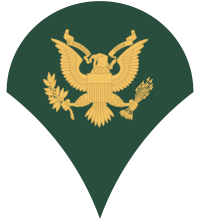|
Army SpecialistE-4 Enlisted Soldier, U.S. Army |
|
Army Ranks » Specialist Rank • SPC Pay • SPC Rank History • Promotion Information
 History of the Army Specialist Rank
History of the Army Specialist Rank
A Specialist is a Enlisted Soldier in the United States Army at DoD paygrade E-4.
The rank of Specialist in the United States Army has a long history. Up until World War II, the ranks of private could be given a specialist designator to show highly specialized knowledge of a certain military trade or craft.
During World War II, the designator of specialist was abolished and replaced by the title of "technician," a chance reflecting the need in fully established modern warfare for deep technical knowledge in a multitude of different arenas.
In 1955, the Army again changed its rank structure with respect to the title given to soldiers of highly specialized knowledge of individual responsibilities and tasks, establishing several grades of specialist—Specialist Third Class, Specialist Second Class, Specialist First Class, and Master Specialist—that eventually gave way to the single rank of Specialist that holds today.
Several years later, in 1958, two more grades of specialist were added and the existing four were reclassified, bringing the total to six, consisting of: Specialist Four (formerly Specialist Third Class), Specialist Five (formerly Specialist Second Class), Specialist Six (formerly Specialist First Class), Specialist Seven (formerly Master Specialist), and the new super-grade specialist ranks of Specialist Eight and Specialist Nine.
These ranks corresponded to the non-commissioned officer (NCO) ranks of E-4 to E-8, but soldiers holding the specialist ranks were not considered NCO's, rather soldiers with deep levels of technical experience and knowledge serving in support of NCO's leading the Army's soldiers.
With the advent of the NCO rank of Command Sergeant Major (E-9), the super-grade specialist ranks, Specialist Eight and Specialist Nine, were abolished. By 1985, the Army had further discontinued the ranks of Specialist Five, Six, and Seven reasoning that soldiers holding NCO ranks had the self-same degrees of experience and technical knowledge, according to their rank and branch specialty, for which the specialist ranks were originally created. Thus, all soldiers with experience and knowledge deserving rank beyond that of Specialist Four would be NCO's from that point onward.
The title of Specialist Four officially become the rank of simply "Specialist," which still holds today. It shares the grade of E-4 with the rank of Corporal, a non-commissioned officer, but Specialists remain soldiers, not NCO's.
Want to learn more? Read about the Army's Specialist rank on Military-Ranks.org.
History of the Army
The Army is the oldest and most senior among the branches. The Army's heritage is traced back to the Revolutionary War, when each State of the Union had its own Army, lended to the command of General George Washington. Almost 250 years have passed, but the organizational structure and naming is largely the same. The Army is still divided into Divisions, Brigades, Regiments, Battalions, Companies, and Platoons.







































































































































